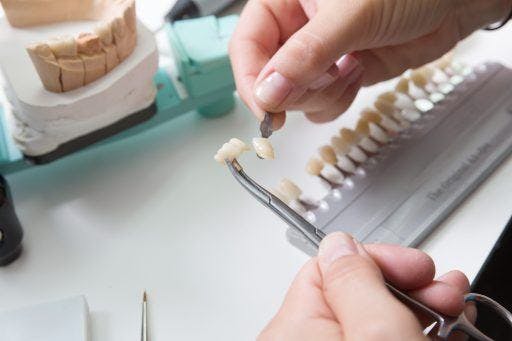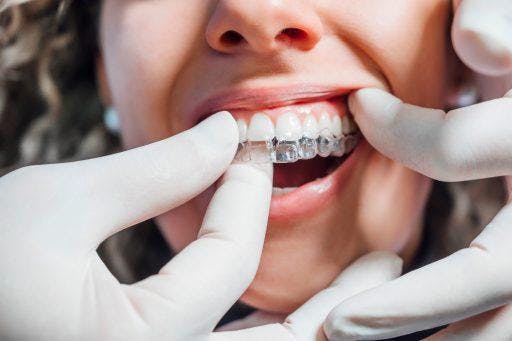The world really is your oyster when it comes to the options available for a great smile. In dentistry, there are various treatments you can undergo to take better care of your teeth. Professional dental treatments can include anything, from routine procedures (like annual cleaning or dental scaling) to more complex, long-term therapy (like orthodontic treatments or oral surgery).
So, if you are wondering what type of dental treatment your dentist might recommend, look no further. Here’s a roundup of some of the most common options and the problems they address. There really are so many ways to get a set of pearly whites that will give you greater smile confidence!
7 dental treatments to ask your dentist about

Work with your dentist to figure out which treatments are best for you. Use this general list of dentist services as a guide to jumpstart those conversations.
1. Cleaning and whitening
Most dentists recommend that patients undergo professional teeth cleaning (otherwise known as “dental prophylaxis”) at least twice a year. Unlike daily teeth brushing and flossing, professional cleaning is more thorough and involves the removal of stubborn plaque buildup. It’s a preventative measure against various dental issues, including cavities and gum disease.
Teeth whitening can be an additional benefit of professional cleaning. It’s also a separate procedure that dentists offer. It’s a relatively painless process for bleaching teeth. Since it’s natural for teeth to discolour over time, some may choose to undergo whitening routinely (at least once a year) for maintenance.
2. Extractions
A tooth extraction sounds extreme, but it’s one of the most common dental procedures patients can go through. As you’ve probably guessed by the name, it refers to pulling or “extracting” teeth from their socket. It’s often the last resort when a damaged tooth can’t be saved through other means, for example, fillings or crowns.
3. Root canal treatment
This procedure falls under endodontics, which deals with the study and treatment of dental pulp. If your dentist discovers an infection at the centre of a tooth (the root canal system), they may recommend this treatment. The method effectively removes the infection and prevents it from spreading.
It may save a tooth that would otherwise require extraction. If you’re experiencing a persistent toothache, reach out to your dentist so they can determine the source. While the infection may be painful, the procedure to treat it isn’t. Patients receive a local anesthetic to numb the affected area. Thank goodness for that!
4. Crowns, fillings, and bridges

These three refer to different options for repairing or replacing missing, decayed, or damaged teeth. They enable the teeth to recover with fewer issues. All call for relatively quick and painless procedures.
- Dental crowns are custom-made to fit over an existing tooth with damage to its top. It serves as a cap or cover that prevents further deterioration. This option is better for teeth with larger cavities.
- Dental fillings are for smaller cavities. Dentists remove the decayed portion of a tooth, so they can refill the area with the appropriate materials like gold or porcelain.
- Dental bridges “bridge” the gaps between teeth. They’re fixed prosthetics or a replacement for missing teeth. They help prevent the surrounding teeth from shifting into empty spaces.
5. Dentures and implants
Dentures, or false teeth, seamlessly replace natural teeth. A full set of dentures replace all missing teeth, while a partial set replaces one or more. They fit snugly over your gums, enabling the wearer to eat, speak, and exercise facial muscles comfortably. They’re also completely removable.
Meanwhile, dental implants are a fixed alternative to removable dentures. They’re surgically implanted into the jaw. Like dentures, they help the wearer perform daily tasks like chewing or speaking. They also support dental prosthetics like crowns or bridges.
6. Braces and aligners

Braces are orthodontic devices that align, straighten, and improve the positioning of misaligned teeth. With consistent use, they should help the patient develop a healthy bite free of crooked teeth.
When people think of dental braces, they usually think of traditional metal-wired braces. After all, they’re the most common type. They move teeth to the desired position with fixed metal brackets and wires. But clear aligners are becoming increasingly popular as an alternative, especially among people looking for more discreet orthodontic treatment.
Clear aligners are undetectable, removable, and fit seamlessly over teeth. ClearCorrect is one of the global leading brands under the Straumann Group. It uses a medical-grade, triple-layer plastic material called ClearQuartz. The material makes them incredibly durable and stain-resistant. They also maintain their shape and comfortable grip throughout treatment. Aligners apply gentle, consistent pressure on misaligned teeth to straighten them out.
Are you considering getting clear aligners? Ask your dentist to walk you through the process, so you know what you’re committing to. Certified ClearCorrect providers use ClearPilot to plan your teeth movement, so you’ll be able to visualise your teeth’s alignment journey. Think of it as your dental GPS!
You can also take this online smile assessment to find out if you’re a candidate.
7. Veneers
Dental veneers are shells that fit over the front section of teeth to conceal cosmetic imperfections. High-quality veneers should look identical to natural teeth. For the most part, they simply improve the look of teeth but don’t offer any reparative benefits. They’re best for people who have otherwise healthy teeth but want to improve the look of discolouration and minor gaps or cracks.
Different types of dental practitioners
If you’re considering dental treatments, discussing options with a dental professional should be your first step. In Australia, most dental practitioners are general dentists. They can assess, diagnose, treat, manage, and provide preventive care for various conditions. General dentists typically complete either a 4-year undergraduate degree or a 4-year postgraduate master’s course.
Optionally, the following dental practitioners can guide you through certain treatments:
- Dental hygienist – helps prevent and control oral diseases through educational and therapeutic methods. They require a minimum of a 2-year advanced diploma or a 3-year undergraduate course.
- Dental therapist – focuses on treating patients under 18. They must complete at least a 3-year undergraduate program.
- Oral health therapist – combines the roles of a dental hygienist and a dental therapist, having completed a minimum 3-year undergraduate degree.
- Dental prosthetist – makes, fits, supplies, and repairs dentures and other dental appliances.
There are also several specialised dentists you might encounter, each with a specific focus:
- Orthodontist – treats dental misalignments, problematic bites, and jaw issues.
- Oral surgeon – provides surgical services for oral diseases and injuries.
- Endodontist – specialises in root canal treatments.
- Periodontist – focuses on treating gum diseases and issues involving the bone structure supporting the teeth.
- Prosthodontist – specialises in crowns, bridges, and dentures.
- Paediatric dentist – caters to the dental needs of children up to 17 years old.
Numerous dental treatments are available to help improve your teeth and overall dental health. Consult with a dental practitioner to determine which procedures, if any, will suit your needs. There’s nothing quite like having a sparkling set of pearly whites that will give you that extra boost of confidence!



